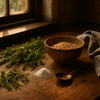Metal Tongs: 5 Essential Types for Every Kitchen
Metal tongs are the unsung heroes of the kitchen—those reliable extensions of your hand that grip, flip, and serve with precision when your fingers can't take the heat. Whether you're flipping a perfectly seared steak, delicately arranging asparagus spears, or serving up pasta like a pro, the right pair of metal tongs makes all the difference between kitchen confidence and culinary chaos.
At DI ORO, we believe that understanding your tools is the first step to cooking brilliance—and metal tongs deserve your attention.
Key Takeaways
- Metal tongs are essential kitchen tools that provide precision when gripping, flipping, and serving food.
- They help protect your fingers from heat while handling hot dishes.
- The right pair of metal tongs enhances your cooking confidence and efficiency.
- Metal tongs are versatile and useful for various tasks, from searing steak to serving pasta.
- Understanding and choosing the right metal tongs is key to improving your culinary skills.
Table of Contents
- Metal Tongs: The Kitchen Multitasker You Can't Live Without
- Understanding Metal Tongs: Not Just Glorified Tweezers
- 5 Essential Types of Metal Tongs Every Kitchen Needs
- How to Choose the Right Metal Tongs for Your Cooking Style
- Types of Metal Tongs: Finding Your Perfect Match
- What Makes Quality Metal Tongs Worth the Investment
- Pro Techniques: Mastering Metal Tongs in Your Kitchen
- Choosing Your Perfect Metal Tongs: Decision Factors
- Metal Tongs in Professional Kitchens: Lessons from the Pros
- Making Your Final Metal Tongs Selection
- Conclusion: Elevating Your Cooking Through Better Tools
Think of metal tongs as the Swiss Army knife of kitchen tools: versatile, essential, and surprisingly complex in their variety. From the robust, long-handled versions that keep your hands safely away from the grill to the delicate, precision pairs that help you plate with restaurant-worthy finesse, there's a world of options beyond that basic pair hiding in your utensil drawer.
Ready to elevate your cooking game? Let's dive into the world of metal tongs and discover which types deserve a spot in your kitchen arsenal. For a comprehensive look at how to select the best kitchen tongs for your needs, check out The Ultimate Guide to Choosing Perfect Kitchen Tongs from DI ORO.
Understanding Metal Tongs: Not Just Glorified Tweezers

Before we jump into the specific types of metal tongs that will revolutionize your cooking, let's get a handle on what makes these tools so indispensable. Metal tongs essentially function as heat-resistant extensions of your fingers, allowing you to manipulate food with precision while keeping your hands safely away from heat, splatter, and mess.
The beauty of metal tongs lies in their simple yet ingenious design: two arms connected at one end with a spring mechanism that provides the perfect amount of tension for gripping without crushing. This seemingly straightforward tool has evolved considerably over the years, with manufacturers fine-tuning everything from materials to ergonomics. For more on the different types and uses of tongs, this comprehensive guide offers great insights.
What Are They Made Of? Construction Materials Matter
When it comes to metal tongs for cooking, construction materials significantly impact performance, durability, and cooking applications. The primary options include:
- All-stainless steel tongs: Durable workhorses that handle extreme heat like champions but conduct that heat to your hands if left over a flame too long
- Stainless steel with silicone tips: The perfect marriage of durability and cookware protection, preventing scratches on your precious non-stick surfaces
- Stainless steel with coated handles: Offering improved grip and heat insulation for comfortable extended use
At DI ORO, we're particularly attentive to materials because what touches your food matters. Just as we insist on forever-chemical-free silicone for our award-winning spatulas, we believe your tongs should meet the same exacting standards for both performance and health.
Design Features That Separate Good Tongs From Great Ones
Not all metal tongs are created equal. The difference between a frustrating cooking experience and effortless food manipulation often comes down to these key design elements:
- Spring tension: Too tight and you'll fatigue your hand; too loose and you'll drop that perfectly seared scallop
- Scalloped edges: These provide superior grip on foods of various textures and sizes
- Locking mechanisms: Essential for storage and safety, the best designs lock and unlock with one hand
- Handle ergonomics: Contoured grips reduce fatigue during marathon cooking sessions
The perfect pair of metal tongs feels like a natural extension of your arm—responsive, balanced, and intuitive. When you find that magical pair, cooking transforms from task to pleasure.
5 Essential Types of Metal Tongs Every Kitchen Needs
Now that we've covered the basics, let's explore the five types of metal tongs that deserve space in your kitchen arsenal. Each serves a specific purpose, and once you experience the right tool for the right job, you'll wonder how you ever managed without them.
1. All-Purpose Kitchen Tongs: Your Everyday Companion
If you could only own one pair of metal tongs (though why limit yourself?), the 12-inch all-purpose kitchen tong would be your desert island choice. These versatile performers handle everything from tossing salads to flipping chicken breasts with equal aplomb.
The ideal all-purpose metal tongs feature:
- Medium length (approximately 12 inches) for balanced reach and control
- Scalloped edges that align perfectly for precise gripping
- A comfortable, heat-resistant handle that won't slip when wet
- A simple locking mechanism that can be engaged with one hand
Think of all-purpose tongs as your kitchen's utility player—not specialized for any single task but remarkably capable at almost everything. They're the first pair you'll reach for and likely the ones you'll use most often. For a reliable option, consider the 2-Piece Kitchen Tongs Set (9-Inch and 12-Inch) by DI ORO, which covers both daily and specialty needs.
2. Professional Grilling Tongs: Long-Handled Heat Warriors
When the cooking gets hot, standard tongs just won't cut it. Professional kitchen tongs designed for grilling feature extended length (typically 16-18 inches) that keeps your hands safely away from flames while giving you complete control over your food.
The best grilling tongs offer:
- Extra-long handles with heat-resistant grips
- Heavy-duty construction that won't bend under the weight of large cuts
- Wider scalloped edges to securely grip larger items
- All-metal construction for durability in extreme heat
Whether you're managing a row of sizzling steaks or rearranging charcoal, these specialized metal tongs for cooking transform a potentially dangerous situation into a comfortable cooking experience. They're essential for outdoor cooking enthusiasts but equally valuable for indoor tasks involving high heat or deep pots.
3. Precision Metal Tongs: For Delicate Work and Plating
At the opposite end of the spectrum from their brawny grilling cousins, precision metal tongs (sometimes called "chef's tongs") excel at delicate tasks and fine detail work. These smaller tools—typically 7-9 inches in length—offer enhanced control for tasks that require a gentle touch.
Look for precision tongs with:
- Perfectly aligned, fine-tipped ends for precise food placement
- Lighter spring tension for delicate grip control
- Smaller overall size for improved maneuverability
- Elegant design that transitions seamlessly from kitchen to table
These metal tongs small enough to handle intricate work shine when you're arranging garnishes, plating delicate components, or turning small items like shrimp or scallops. They're the secret weapon of chefs who care about presentation and control.
4. Silicone-Tipped Metal Tongs: Non-Stick Surface Protectors
The kitchen tool equivalent of having your cake and eating it too, silicone-tipped metal tongs combine the strength and durability of stainless steel with the gentle touch of silicone. These hybrid tools are essential for anyone who values their non-stick cookware.
The best silicone-tipped tongs feature:
- High-quality, heat-resistant silicone tips (ideally FDA-approved and BPA-free)
- Seamless construction that prevents food particles from getting trapped
- Stainless steel framework for durability and strength
- Balanced weight distribution for comfortable handling
These tongs excel at tasks where metal might scratch or damage surfaces—flipping delicate fish fillets in a non-stick pan, tossing pasta in an enameled Dutch oven, or serving from coated bakeware. They're the considerate choice that protects your investment in quality cookware. For tips on avoiding scratches on non-stick pans, see our award-winning Chef 3-Piece Silicone Spatula Turner Set as a great companion to silicone-tipped tongs.
5. Specialized Serving Tongs: From Kitchen to Table
The final essential category bridges the gap between cooking and serving. Specialized serving tongs are designed with aesthetics and function in mind, elegant enough for the table but practical enough for real use.
Quality serving tongs typically offer:
- More refined, attractive finishes suitable for tableside presentation
- Task-specific designs (pasta tongs, salad tongs, ice tongs)
- Balanced weight that feels substantial without being cumbersome
- Ergonomic design that works for both serving and self-service
From the dramatic tableside tossing of a Caesar salad to the precise placement of ice cubes in a cocktail, these specialized tools elevate the dining experience while remaining fundamentally practical. They're the finishing touch that shows attention to detail in both cooking and presentation.
How to Choose the Right Metal Tongs for Your Cooking Style

With so many options available, selecting the perfect metal tongs might seem overwhelming. However, understanding your cooking habits and preferences makes the decision much simpler. Consider these factors when building your collection:
Consider Your Cooking Techniques
Your cooking style should guide your tong selection:
- For high-heat cooking and grilling: Prioritize longer, all-metal tongs that can handle extreme temperatures
- For delicate fish and eggs: Silicone-tipped tongs will be your best friends
- For precise plating and garnishing: Invest in smaller, precision tongs
- For family-style serving: Consider dedicated serving tongs that transition elegantly to the table
Most home chefs find that a combination of at least two types—typically all-purpose and silicone-tipped—covers most cooking scenarios. Professional kitchen tongs designed for specific tasks can be added as your cooking repertoire expands.
At DI ORO, we believe that quality tools elevate your cooking experience from mundane to magical. Just as our award-winning spatulas have transformed flipping and folding for home chefs, the right metal tongs can revolutionize how you grip, turn, and serve. Because when you're creating something memorable—whether it's a simple weeknight dinner or a holiday feast—having the right tools makes all the difference. For more in-depth advice, see our Designer Series blog for tips on choosing and caring for premium kitchen tools.
Types of Metal Tongs: Finding Your Perfect Match
Now that we understand what makes metal tongs tick, let's dive deeper into the specific types that will transform your cooking experience. Each design serves a distinct purpose, and knowing which to reach for can make the difference between kitchen frustration and culinary triumph. If you're curious about more specialized types, this expert guide provides extra background.
Everyday Kitchen Tongs: The Workhorses
Your standard 12-inch kitchen tongs are the true MVPs of your utensil drawer. These versatile tools handle everything from tossing a stir-fry to serving salad with equal confidence. The best everyday metal tongs feature perfectly balanced spring tension—firm enough to grip securely but gentle enough to prevent hand fatigue during marathon cooking sessions.
Look for models with scalloped edges that align precisely when closed. This design creates multiple contact points with food, ensuring that slippery pasta strands or delicate asparagus spears stay put. A comfortable, heat-resistant handle is non-negotiable, as is a locking mechanism that doesn't require an engineering degree to operate.
When America's Test Kitchen evaluated everyday metal tongs, they found that the sweet spot for length is indeed 12 inches—long enough to keep your hands away from splatter but short enough for precise control. This is your desert island kitchen tool, the one you'll reach for most often.
BBQ and Grilling Tongs: The Heat Tamers
When you're facing down flames and searing temperatures, professional kitchen tongs specifically designed for grilling become essential. These 16-18 inch warriors keep your hands at a safe distance while giving you the control needed to flip, turn, and position food with confidence.
The best grilling tongs feature robust construction with thicker gauge metal that won't bend under the weight of a hefty steak or roast. Look for models with wider scalloped edges to provide maximum grip on larger cuts of meat. Heat-resistant handles are crucial—the last thing you need is a handle that becomes too hot to hold mid-grill session.
"I've seen too many home chefs try to manage a grill with standard kitchen tongs," says grilling expert Elizabeth Karmel. "It's like trying to change a tire with tweezers—technically possible but unnecessarily difficult and potentially dangerous." For a full breakdown of tong types and their unique uses, see this authoritative guide.
Precision Tongs: The Detail Artists
At the opposite end of the spectrum from their brawny grilling cousins are precision metal tongs small enough for delicate work. Typically measuring 7-9 inches, these refined tools excel at tasks requiring a gentle touch and pinpoint accuracy.
The best precision tongs feature finely aligned tips that can pick up a single herb leaf or position a delicate garnish with surgical precision. Their shorter length provides enhanced control and maneuverability, making them ideal for intricate plating or working in tight spaces.
Professional chefs often keep precision tongs within arm's reach for those moments when presentation matters as much as flavor. Their lighter spring tension allows for delicate manipulation without crushing tender ingredients—perfect for turning seared scallops or arranging edible flowers.
Silicone-Tipped Tongs: The Surface Protectors
For those who've invested in quality non-stick cookware, silicone-tipped metal tongs are worth their weight in gold. These hybrid tools combine the strength and durability of stainless steel with silicone tips that won't scratch or damage delicate cooking surfaces.
The silicone components should be heat-resistant to at least 450°F, allowing them to handle most cooking tasks without melting or warping. Look for models where the silicone is securely bonded to the metal framework—gaps or seams can trap food particles and become bacterial breeding grounds.
Many home chefs find that silicone-tipped tongs become their go-to option for everyday cooking, offering the perfect balance of functionality and cookware protection. They're particularly valuable when working with fish, eggs, or other delicate proteins that might stick to all-metal alternatives.
Specialized Serving Tongs: The Elegant Transitions
The final category bridges the gap between cooking and presentation. Specialized serving tongs are designed with both function and aesthetics in mind, elegant enough for the table but practical enough for actual use.
From dedicated pasta tongs with wide, curved heads perfect for gripping long noodles to elegant salad servers that make tossing and serving a breeze, these specialized tools elevate both the cooking and dining experience. Look for models with comfortable grip points and balanced weight distribution.
Many specialized serving tongs feature distinctive designs tailored to specific foods—think slotted fish servers, broad spatula-like ends for lasagna, or pronged tips for serving bacon. While not essential for every kitchen, these specialized tools can make serving particular dishes significantly easier and more elegant.
What Makes Quality Metal Tongs Worth the Investment

Not all metal tongs are created equal. The difference between a frustrating cooking experience and kitchen confidence often comes down to subtle details that separate quality tools from mediocre ones. Here's what to look for when investing in tongs that will last:
Construction and Materials: Building to Last
Quality metal tongs start with superior materials. Look for 18/10 stainless steel, which contains 18% chromium and 10% nickel—this composition offers excellent corrosion resistance and durability. Avoid tongs that feel lightweight or flimsy; a certain heft indicates quality construction that won't bend or warp under pressure.
Pay attention to how the arms connect to the spring mechanism. The best metal tongs feature solid construction with secure rivets or welds rather than cheap mechanical connections that can fail. When America's Test Kitchen evaluated professional kitchen tongs, they found that two-piece designs with a single solid piece forming both arms proved most durable.
For silicone components, look for medical-grade or food-grade silicone that's certified BPA-free and heat-resistant to at least 450°F. Just as DI ORO insists on forever-chemical-free silicone for our award-winning spatulas, your tongs should meet the same exacting standards for both performance and health.
Ergonomics and Comfort: The Hand-Feel Factor
You'll likely spend hours with your metal tongs in hand, so comfort matters tremendously. Quality tongs feature ergonomic handles designed to reduce fatigue during extended use. Look for contoured grips that fit naturally in your hand and provide secure purchase even when wet or greasy.
The spring mechanism deserves special attention—it should provide consistent tension that's firm enough to grip securely but not so stiff that it tires your hand. The best tongs find that Goldilocks zone of just-right resistance that makes them feel like a natural extension of your fingers.
Weight distribution also plays a crucial role in comfort. Well-designed metal tongs balance the heavier gripping ends against comfortable handles, creating a tool that feels nimble rather than unwieldy. This balance becomes particularly important during lengthy cooking sessions.
Locking Mechanisms: Convenience Meets Safety
A quality locking mechanism transforms good tongs into great ones. The best designs allow you to lock and unlock with one hand—typically by pulling a ring or pushing a tab—leaving your other hand free to manage food or cookware.
Look for locking mechanisms that stay securely engaged when stored but release easily when needed. Avoid designs with awkward locks that require two hands or significant force to operate—these become frustrating obstacles during active cooking.
Some premium metal tongs feature innovative locking systems that engage when the tongs are pointed downward and release when lifted—a clever design that allows for one-handed operation without buttons or tabs. While not essential, these thoughtful features demonstrate the manufacturer's attention to real-world cooking scenarios.
Pro Techniques: Mastering Metal Tongs in Your Kitchen
Owning quality metal tongs is just the beginning—learning to use them with skill and confidence transforms them from simple tools into extensions of your culinary creativity. Here are techniques the pros use to get the most from their tongs:
The Perfect Grip: Hand Positioning for Control
Professional chefs hold their metal tongs like an extension of their arm, not as a separate tool. Position your thumb and index finger at the pivot point for maximum control, with remaining fingers wrapped around the handle. This grip provides the finest control over pressure and movement.
For delicate tasks, choke up on the handles to reduce the leverage and gain more precise control. Conversely, when managing larger items or reaching into deep pots, slide your grip back toward the end of the handles for increased reach and leverage.
Practice the "tong click"—that rhythmic testing of tension that chefs do almost unconsciously. This not only ensures your tongs are functioning properly but also helps calibrate your grip strength for the task at hand. It's the culinary equivalent of a tennis player bouncing the ball before serving.
Food-Specific Techniques: Adapting to Ingredients
Different foods require different handling techniques with metal tongs. For delicate fish fillets, use silicone-tipped tongs and grip from the side rather than pressing down from above. This preserves the integrity of the flesh while providing secure handling.
When managing long pasta with specialized pasta tongs, use a gentle lifting and turning motion rather than aggressive grabbing. Allow the curved design of the tongs to do the work of collecting and holding the noodles.
For awkwardly shaped items like bone-in chicken pieces, identify the most stable gripping point before attempting to flip or move the food. This prevents the frustrating chase around the pan that can occur when tongs lose their grip mid-movement.
Maintenance and Care: Extending Tong Lifespan
Quality metal tongs can last for decades with proper care. Always hand-wash tongs with moving parts or silicone components, even if they're labeled dishwasher-safe. The harsh detergents and high heat of dishwashers can degrade springs and bonding materials over time.
Periodically check and tighten any screws or mechanical connections. Apply a drop of food-grade mineral oil to spring mechanisms if they begin to squeak or show resistance. For silicone-tipped models, inspect regularly for any separation between the metal and silicone components.
Store your tongs either hanging from hooks (many models feature hanging loops for this purpose) or locked in the closed position in a drawer. This prevents unnecessary strain on the spring mechanism and protects the tips from damage.
Choosing Your Perfect Metal Tongs: Decision Factors

With so many options available, how do you build the ideal collection of metal tongs for your kitchen? Consider these factors when making your selection:
Your Cooking Style: Match Tools to Techniques
Your cooking habits should dictate your tong selection. If you're an avid griller, prioritize investing in high-quality, extended-length grilling tongs that can handle extreme temperatures. If you create elaborately plated dishes, precision tongs will prove invaluable for your artistic presentations.
Consider the types of cookware you use most frequently. Heavy non-stick users should prioritize silicone-tipped models that won't damage coatings, while those who cook primarily with stainless steel or cast iron might prefer the durability and precision of all-metal designs.
Think about your entertaining style as well. If you frequently serve family-style meals, dedicated serving tongs that transition elegantly from kitchen to table might be worth the investment. If you rarely entertain, you might prioritize versatility over specialized serving tools.
Budget Considerations: Where to Invest
Quality metal tongs range from affordable basics to premium professional models. If budget constraints prevent purchasing multiple specialized pairs, prioritize a high-quality set of 12-inch all-purpose tongs with silicone tips. This versatile option covers the broadest range of cooking tasks.
Consider the cost-per-use factor when evaluating prices. A $30 pair of professional kitchen tongs used daily for years offers better value than a $10 pair that warps, breaks, or becomes frustrating after a few months. Quality tools pay dividends in cooking enjoyment and results.
Many professional chefs recommend investing in fewer, better tools rather than accumulating numerous mediocre ones. A thoughtfully curated collection of three quality tongs—all-purpose, grilling, and precision—will serve most home cooks better than a drawer full of subpar options. For more expert insights on tong selection and other kitchen essentials, explore our in-depth tongs buying guide.
At DI ORO, we believe that cooking should be a joy, not a chore. The right metal tongs—like our award-winning spatulas—transform cooking from a series of tasks into an expression of creativity. When your tools work with you rather than against you, you're free to focus on the flavors, techniques, and presentation that make your food uniquely yours.
Metal Tongs in Professional Kitchens: Lessons from the Pros
Professional chefs have a special relationship with their metal tongs. In the high-pressure environment of restaurant kitchens, these tools become almost like extensions of the chef's hands. "I can always spot a seasoned cook by how they handle their tongs," says Chef Michael Voltaggio. "There's a confidence and fluidity that comes from thousands of hours of practice."
In professional kitchens, you'll often see color-coded tongs used to prevent cross-contamination—red for raw meat, blue for seafood, green for vegetables. This systematic approach ensures food safety while maintaining the fast pace demanded in commercial settings. It's a smart practice home cooks can adopt, especially when preparing complex meals with multiple components.
Many professional chefs also personalize their metal tongs with colored tape or markings, not just to prevent theft in busy kitchens, but to quickly identify their preferred tools. It's a testament to how personal these seemingly simple instruments become when you're using them for hours every day.
Metal Tongs for Special Dietary Needs
For those managing food allergies or special diets, dedicated metal tongs can be literal lifesavers. Using separate tongs for allergen-containing foods prevents cross-contact that could trigger serious reactions. The distinct advantage of metal tongs in this scenario is their non-porous surface, which doesn't harbor proteins or residues when properly cleaned.
For households managing celiac disease, having dedicated metal tongs for gluten-free cooking provides peace of mind. Unlike wooden tools that can harbor gluten in their grain, properly cleaned metal tongs offer a safer alternative for handling gluten-free foods.
Kosher and halal kitchens similarly benefit from multiple sets of metal tongs to maintain religious dietary laws. The durability of quality stainless steel tongs makes them ideal for these applications, as they maintain their integrity through frequent washing and sterilization.
Innovative Tong Designs Worth Considering
The world of metal tongs continues to evolve with innovative designs addressing specific culinary challenges. Offset tongs, with heads angled slightly from the handles, provide improved visibility when working with flat foods like pancakes or delicate fish fillets. This small design tweak makes a noticeable difference in precision and control.
Convertible tongs that transform from cooking to serving tools with interchangeable heads offer versatility for those with limited storage space. While these Swiss Army knife-style tools don't always match the performance of dedicated single-purpose tongs, they can be valuable space-savers in compact kitchens.
For those with arthritis or hand strength issues, ergonomically designed metal tongs with cushioned grips and assisted-spring mechanisms reduce the force required for operation. These thoughtfully engineered tools demonstrate how inclusive design can make cooking more accessible without sacrificing performance.
Making Your Final Metal Tongs Selection
After exploring the wide world of metal tongs, you might be wondering which ones truly deserve a place in your kitchen. The answer, like many aspects of cooking, depends on your personal style and needs. However, there are some universal considerations that can guide your decision.
The Essential Tongs Collection
If you're building your collection from scratch, start with these three essential types:
- 12-inch silicone-tipped tongs for everyday cooking and non-stick protection
- 16-inch all-metal tongs for grilling and high-heat applications
- 9-inch precision tongs for delicate work and plating
This trio covers virtually every cooking scenario you'll encounter, from flipping burgers on a scorching grill to placing a delicate herb garnish on a finished plate. If budget constraints force you to choose just one, the 12-inch silicone-tipped model offers the most versatility for most home cooks.
For those who entertain frequently, consider adding a pair of elegant serving tongs that complement your tableware. These can elevate the presentation of everything from salads to roasted vegetables, bringing a touch of restaurant polish to your home dining experience.
Quality Indicators: What to Look For
When evaluating metal tongs, pay attention to these quality indicators:
- Weight and balance: Quality tongs have a substantial feel without being heavy
- Smooth operation: The spring mechanism should open and close with consistent tension
- Precise alignment: The tips should meet perfectly when closed
- Secure connections: No wobbling or looseness at joints or connection points
- Comfortable grip: Handles should feel natural in your hand, even during extended use
Remember that like DI ORO's award-winning spatulas (recognized by America's Test Kitchen for their exceptional performance), the best metal tongs combine thoughtful design with quality materials. They should feel like they were designed by someone who actually cooks, not just engineered to hit a price point.
Conclusion: Elevating Your Cooking Through Better Tools
The humble metal tongs may not get the glory of fancy knives or showy appliances, but they're the unsung heroes of everyday cooking. From precisely flipping a delicate piece of fish to confidently handling a sizzling steak on the grill, quality metal tongs transform challenging tasks into effortless movements.
At DI ORO, we understand that great cooking starts with great tools. Just as our silicone spatulas have earned accolades from America's Test Kitchen and Cook's Illustrated for their performance and design, we recognize that every tool in your kitchen should meet that same standard of excellence. Whether you're a professional chef or an enthusiastic home cook, investing in quality metal tongs is an investment in your culinary future—one flip, grab, and serve at a time.
Frequently Asked Questions
What are metal tongs used for?
Metal tongs are versatile kitchen tools designed for gripping, lifting, and turning food items with precision and safety. They’re perfect for tasks like flipping steaks on the grill, serving salads, or retrieving hot items from boiling water. Their sturdy construction allows them to handle heavy or slippery foods without bending or breaking.
What do chefs use instead of tongs?
When chefs opt not to use tongs, they often rely on tools like spatulas, forks, or even their hands with heat-resistant gloves for delicate or specific tasks. For example, a fish spatula can be ideal for flipping fragile fillets, while a fork is handy for turning smaller items. However, tongs remain a favorite for their control and versatility in most cooking scenarios.
Are metal or silicone tongs better?
Choosing between metal and silicone tongs depends on your cooking needs. Metal tongs offer robust strength and heat resistance, great for high-heat grilling or searing. Silicone tongs, on the other hand, are gentler on non-stick cookware and heat-resistant up to certain temperatures, making them ideal for delicate foods and safer for coated pans.
What are the three types of tongs?
The three common types of tongs include locking tongs, spring-action tongs, and scissor-style tongs. Locking tongs can be snapped shut for easy storage, spring-action tongs open and close with a squeeze for quick handling, and scissor-style tongs pivot like scissors for precision grip. Each offers unique advantages depending on your kitchen tasks.
What are steel tongs used for?
Steel tongs are prized for their durability and heat resistance, making them ideal for grilling, frying, and handling hot foods safely. They provide a firm grip on heavy or tough ingredients like steaks, ribs, or roasted vegetables, and their long handles keep your hands safely away from flames and hot surfaces.
What are the Chinese tongs?
Chinese tongs, often called 'chopsticks tongs' or 'hot pot tongs,' are long, slender metal tongs used primarily in Asian cooking. They’re perfect for picking up small pieces of food, especially in hot pot or stir-fry settings, offering precise control similar to chopsticks but with the sturdiness of metal. Their design helps maneuver food in crowded pots or woks effortlessly.




